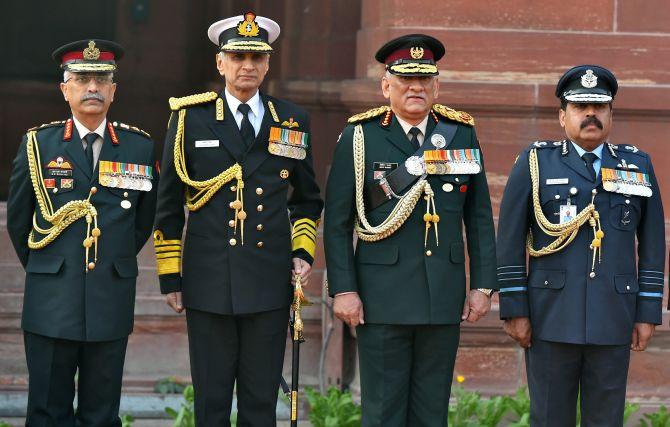As India's international role expands, so must our capabilities, says Brigadier Gurmeet Kanwal (retd).

As a growing regional power, India is being increasingly expected by its strategic partners to become a net provider of security.
On its part, India appears to be more and more willing to accept such a role as a member of a cooperative security network.
But, is it doing enough to acquire the military capabilities necessary for intervention in its regional neighbourhood?
And, who are likely to be India's partners for such a role?
A meeting in November 2018 for the Quadrilateral Security Dialogue for the third time in one year, officials of Australia, India, Japan and the United States -- a group popularly known as the Quad -- agreed to expand their cooperation to establish a free, open and inclusive rules-based order in the Indo-Pacific region amid growing apprehensions about Chinese military assertiveness.

In June 2018, while speaking at the Shangri La Dialogue at Singapore, Prime Minister Narendra Damodardas Modi had said that India's cooperation with its strategic partners was not 'directed against any country', and that India visualises the Indo-Pacific as a space that requires a 'common rules-based order'.
A cooperative security framework will eventually emerge in the Indo-Pacific and, given China's proclivity to steadily creep forward into India's maritime neighbourhood, India must play a substantial role in putting it together.
Among other security issues like cooperation for counter-terrorism, it will involve joint patrolling of the sea lanes of communications, escort operations, anti-piracy measures, search and rescue operations and providing humanitarian assistance and disaster relief (HADR) during natural calamities.
In rare cases, cooperation for security will extend to military interventions. For example, if the Gulf was to be blocked by Iran consequent to its present stand-off and tensions with the US, Saudi Arabia and their allies, the situation could lead to a military response.
Requirement of Intervention Capabilities
Ensuring peace and stability in the Indo-Pacific and maintaining the freedom of the sea lanes of communication for the unfettered flow of trade requires the creation of robust capabilities for military intervention.
Contingences triggering such interventions could include the removal of illegal blockades, the rescue of political hostages (for example, US diplomats held hostage in Teheran, 1979-1981), the restoration of a legitimate regime after a coup (Indian intervention in Maldives, 1988), the overthrow of rogue regimes and the recapture of islands seized illegally by inimical forces.
In the past India has repeatedly required such capabilities, though these were used mostly for HADR purposes.
Starting with the war in Iraq in 2003, through the conflicts in Lebanon (2006), Egypt, Libya and Yemen (2011) and Ukraine and Syria-Iraq (2014), Indian armed forces and civil aviation personnel have been engaged in evacuating beleaguered Indian citizens from war zones.
In the space of ten days in April 2015, India evacuated 5,600 displaced persons from Yemen under Operation Rahat (relief).
Of these, 4,640 were from India and 960 from 41 friendly countries, including citizens of Britain, France and the United States.
They were evacuated by air by the Indian Air Force's C-17 Globemaster aircraft flying from Djibouti, Ethiopia; by Air India aircraft flying from Sana'a; and, by sea on board ships of the Indian Navy from Aden, Al Hudaydah and Al Mukalla ports in Yemen.

Force Structure Required
The late General Krishnaswamy Sundarji, former chief of the army staff, had often spoken of converting an existing infantry division to a Rapid Reaction Division (RRD) with air assault capability by 2000.
However, rapid reaction forces are capital intensive and the shoestring budgets of the 1990s did not allow the army to implement the concept.
Now the time has come to translate General Sundarji's vision into reality. Besides being necessary for out-of-area contingencies, air assault capability is a significant force multiplier in conventional conflict.
The present requirement is of at least one air assault brigade group with integral heli-lift capability for offensive employment on India's periphery by 2022.
Comprising three specially trained air assault battalions, integral firepower component and combat service support and logistics support units, the brigade group should be based on Chinook CH-47 and MI-17 transport helicopters.
It should have the guaranteed firepower and support of two to three flights of attack and reconnaissance helicopters and one flight of UCAVs.
Simultaneously, efforts should commence to raise a RRD by 2025. The first air assault brigade group mentioned above should be a part of this force.
The second brigade group of the RRD should have amphibious capability with the necessary transportation assets being acquired and held by the Indian Navy, including landing and logistics ships.
One brigade group in the army's Southern Command has been recently designated as an amphibious brigade; this brigade group could be suitably upgraded.
The amphibious brigade should be self-contained for 15 days of sustained intervention operations.
The third brigade of the RRD should be lightly equipped for offensive and defensive employment in the plains and the mountains as well as jungle and desert terrain.
All the brigade groups and their ancillary support elements should be capable of transportation by land, sea and air.
Another RRD, the second, should be raised by about 2030 when India's regional responsibilities would have grown considerably.
Special Forces support should be available to these RRDs on as required basis for both conventional conflict and intervention operations.
A permanent tri-Service headquarters equivalent to a Corps HQ should also be raised under HQ Integrated Defence Staff (HQ IDS) for continuous threat assessment and operational planning and to provide C4I2SR support to the RRDs and their firepower, combat service and logistics support components.
Unless planning for the creation of such capabilities begins now, these elite fighting formations will not be available when these are required to be employed during a contingency affecting India's national interests.
Brigadier Gurmeet Kanwal (retd) is former director, Centre for Land Warfare Studies (CLAWS), New Delhi.










